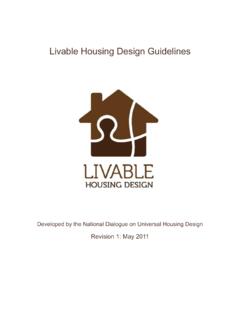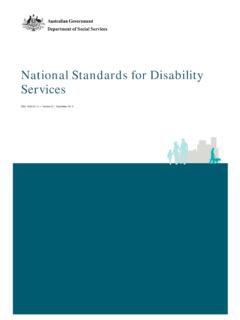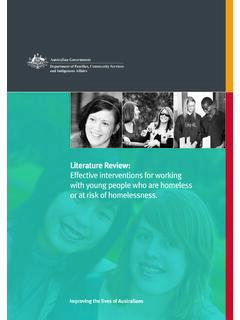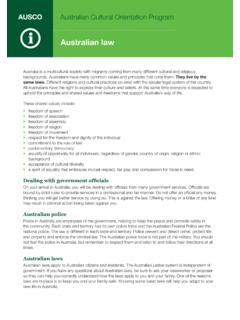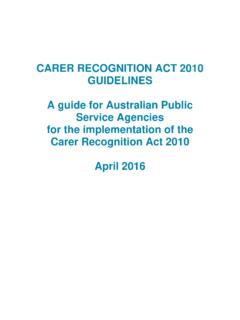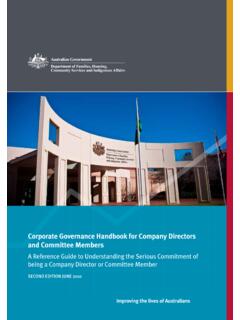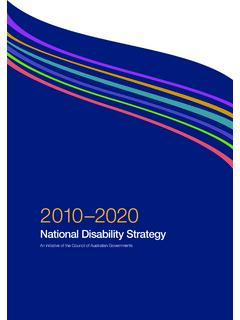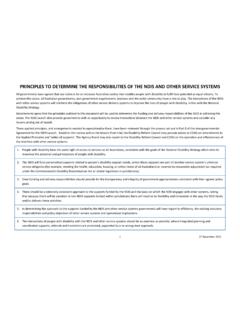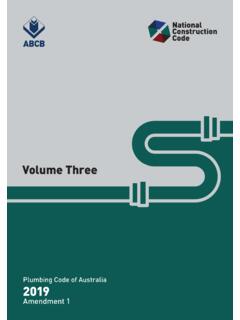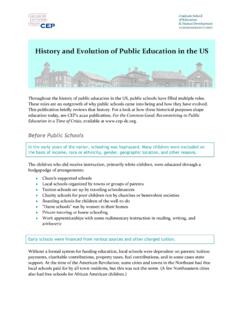Transcription of Guidelines for the Planning and Development of Child Care ...
1 Guidelines for the Planning and Development of Child Care FacilitiesbcUniversity of Technology, SydneyAustralian Centre of Excellence for Local GovernmentLevel 8, 235 Jones StreetUltimo NSW 2007 Telephone: 02 9514 1061 Fax: 02 9514 2274 Website: the exception of the Commonwealth Coat of Arms, the Department s logo, any material protected by a trade mark and where otherwise noted all material presented in this document is provided under a Creative Commons Attribution Australia ( ) licence. The details of the relevant licence conditions are available on the Creative Commons website (accessible using the links provided) as is the full legal code for the CC BY AU licence ( ). The document must be attributed as the Guidelines for the Planning and Development of Child Care 978-1-74361-660-4 Further copies of this document can be downloaded from the Department of Education website 2014 ACkNoWLEDGEmENTST hese Guidelines are funded by the Australian Government Department of of contentsPreface.
2 IGlossary ..iiNavigating this document ..iiiAbout these Guidelines ..ivPart 1 How to use policy and strategic Planning for Child care .. Be Child friendly .. Understand policies and legislation .. Be proactive in community Planning .. Take long term view in operational Planning ..9 Checklist.. 10 Part 2 Enhancing supply through land use Planning .. Align definitions of Child care .. Partner with relevant authorities .. Use flexible land use provisions .. Support zoning for Child care .. Be holistic when master Planning .. Carefully plan urban infill .. Develop Child care friendly Development controls .. Align Development codes ..22 Checklist.. 23 Part 3 Work in collaboration .. Partner with state government .. Engage with the community.
3 Inform councillors and collaborate with local government staff .. Engage with proponents ..32 Checklist.. 33 Conclusion ..35 Best practice checklist ..37 References ..46 Appendix .. 47iiiPrefaceLocal government across Australia makes a vital contribution in securing the well-being of children and families and ultimately strengthening the economy. Ensuring existing and future communities have access to the short and long term community infrastructure they need, including Child care centres, is an ongoing need a mix of Child care service types ranging from family day care, occasional care, home based care, outside school hours care as well as long day care. A Child care facility is defined as a building or place used for the supervision and care of children that provides a learning environment in addition to long day care, preschool, occasional care or outside school hours care.
4 These Guidelines only pertain to long day strong communities and economies requires investment in social services. Land use Planning is an important tool for ensuring this investment. It is clear that Child care has both short and long term societal and economic benefits. It is in this way that Planning for Child care is different to Planning for other the availability and quality of Child care contributes positively to the Development of children, there is also a direct correlation between Child care and workforce participation of parents, especially mothers of young High rates of workforce participation help build strong, self-sustaining communities and vibrant local economies. All local governments shape the availability of Child care through strategic Planning , land use Planning and Development assessment processes.
5 through these functions, local government helps determine the priority given to Child care by the community, where it is located, and the size and the type of Child care government works within a broader context of state and national policy, legislation and regulations which govern the land use Planning and service approval this framework, access to Child care can be facilitated by local government Planning through close collaboration with other government agencies, Child care providers and the local government and their stakeholders face a broad range of challenges when Planning and delivering Child care for current and future communities. These include population changes, satisfying the varied preferences of families, the high cost of land and land availability, zoning restrictions and ensuring efficient Development assessment processes.
6 Many local governments have met these challenges with great success and these Guidelines include short case studies of examples of what can be national level guidance on the Planning and Development of Child care facilities is a challenge as state level legislation and regulations vary. These Guidelines do not address whether local government should be a Child care provider or not. However, they do recognise existing constraints and provide evidence-based, easy to use checklists to help local government build internal capacity to strategically and systematically plan, and work in partnership with a range of stakeholders, to improve the availability of Child care facilityA building or place used for the supervision and care of children that provides long day care, preschool, occasional care or outside school hours care.
7 These Guidelines only pertain to centre based long day based long day careLong day care is a centre-based form of Child care for children from birth to six years old. Community infrastructurePublic and privately provided facilities and services, including local government and other facilities, that are required to accommodate and support community services, programs, activities, and a person s access to siteAn area of agricultural or forest land or some other undeveloped site earmarked for person(s) or entity(ies) with a direct financial interest in a proposed Development that lodges an application for approval of the proposed Development by a Planning planningThe collection of legislation, regulations and other statutory orders which set out technical Planning standards and establish the legal basis under which Planning authorities can enforce these standardsStrategic land use planningThe identification of desired or future types and locations of Development and the implementation of these through the preparation of statutory Planning infillDevelopment that occurs on vacant or remnant lands passed over by previous Development , including the replacement.
8 Remodeling or reuse of existing structures to accommodate new The classification of land in local Planning schemes for use and Development , excluding land in reserves. A zoning table (or use-class table) may be included in a local Planning scheme that sets out the permissibility, uses and classes of land uses in particular zones in the scheme this documentEngage withproponentsInform Councillorsand collaborate with Engage withthe communityPartner with State governmentland use Planning provisionsSupport zoningfor Child careBe holistic whenmaster planningCarefully plan Align developmentcodesDevelop Child care friendly Development controlsPartner withrelevant authoritiesPart 1 How to use policy and strategic Planning for Child carePart 3 How to build stakeholder awareness and supportPart 2 Enhancing supply through land use planningBe Child friendlyUnderstand governmentpolicies and legislationBe proactive in community planningTake long term view in operational planningof Child care Best practice checklist to
9 Work in collaborationBest practice checklist to use policy and strategic Planning processesThe navigation wheel can be used as a tool for you to know where you are within this document. At the beginning of each section, it will show you where it within the Guidelines . On each page, there will also be a small icon to show where you are. Best practice checklist for enhancing supply through land use planningiiiivAbout these guidelinesIntroductionobtaining building approval, Development approval, service approval and registration for Child Care Benefit can be a complex process. Local government can assist proponents to navigate this complexity by helping them to understand the various legislative and regulatory requirements that they will need to meet.
10 Local government can also work to streamline and coordinate the various application and assessment processes in addition to identifying any limiting factors in Planning schemes, such as restrictive zoning or parking requirements. These national Guidelines are designed to enable local government to plan better for the future Child care needs of their communities through strategic and land use Planning . They do not address issues related to quality of service nor whether local government should be a Child care provider. The overall objective is to ensure the adequate supply of long day Child care places through land use Planning . Because this is a national document, these Guidelines should be consulted in conjunction with the state level agencies responsible for the Planning and Development of Child care centres.
